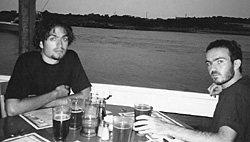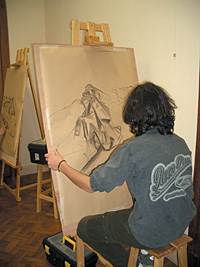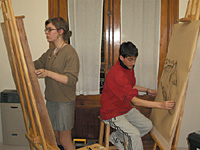|
|
 |
 |
 |
 |
|
ALUMNI PROFILEHelping Out Back HomeBy Amanda May ’97Sebastian Cwilich ’97 uses his American resources to help his native Argentina
If you’re in a privileged position and your country really needs help, it is your responsibility to do what you can,” says Sebastian Cwilich ’97, who was born in Argentina but moved to the United States when he was 8. “The economic crisis in Argentina has created a lot of need, but it also has made it affordable to use American financial resources to provide a lot of help.” Seizing this opportunity, Cwilich, a mathematician for AT&T, and his younger brother, Fernando, the editor of the Black Book Global Nightlife Guides and a self-taught painter who graduated from NYU in 1999, decided that they needed to do something to help their native land. During a visit to Argentina, Fernando’s 14-year-old cousin asked him to send her painting supplies, as her family could no longer afford them. “We had been kicking around the idea of doing something, anything, to help people in Argentina,” Fernando says. “The idea of an art school for students from low-income families seemed to make sense.” With that goal in mind, the brothers created ProyectArte, a New York-based not-for-profit with a school in Buenos Aires for students under 18.
Sebastian and Fernando recruited internationally-renowned
teachers for their project, each one with a specialty,
such as painting or sculpting. “Before this,
it was unheard of to have kids this young learning
from teachers this accomplished,” says Fernando.
Sebastian adds that the teachers are paid a modest
salary. “We’re not paying them so much
that it makes difference in their lives,”
he admits. “But they decided that the school
was new and unique, and they think that they can
produce artists of a new generation.” In addition
to the faculty, Sebastian and Fernando hired two
part-time assistants to work with the artists during
the class, as well as an operations director and
an artistic director to run the school locally. Sebastian and Fernando expect that most of the students will continue with their studies after the initial six-month scholarship by concentrating on one medium and working in greater detail with one of the teachers. Eventually, Sebastian hopes to have both paying and scholarships students. “The model will be that of a college, where the students who can afford to pay help support those who cannot,” he says.
For the current 24 students, the bi-weekly classes started in July. The faculty members rotate, each teaching one two-hour class every five lessons. Classes are held during the evenings, after the children have finished school. In between their lessons, students are given homework. “That was one of the few ways in which we intervened,” Sebastian says, explaining he and Fernando have tried to give the faculty the bulk of the decision-making responsibilities. “We noticed that students didn’t necessarily practice between classes, so we asked the teachers to give them homework.” The brothers also instituted additional studio time, where students can finish work or practice new skills. Sebastian credits his experience at Columbia as motivation for his nonprofit work. “I loved being at Columbia and sitting in class next to one kid whose father was a senator and another kid whose father was a security guard,” he says. “That model, of bringing together different social classes for educational purposes, is what we are trying to replicate with ProyectArte.” With the school up and running, the brothers are turning their attention to fund raising. “Having lived through the dot-com world, we didn’t want people to put up money for something that didn’t exist yet,” Sebastian notes, explaining why he and Fernando footed the bill for the first six months of the school. “Now that we have something concrete and successful, we are starting a fund-raising campaign to help run the school indefinitely.” Part of their fund-raising campaign includes a silent auction at the Argentinean consulate on November 18, where they will auction off everything from Argentine wine to restaurant gift certificates. Sebastian and Fernando hope to expand this model to other economically depressed countries. “We know we’re not solving all the problems of the world,” says Sebastian. “But we hope that this experience will drive these kids and help them succeed.” Amanda May ’97 is a
freelance writer who lives in New York. Her work
has appeared in New York magazine, the
New York Post and Time Out New York.
|
|
||||||||||||||||||||||||||||||||||||||||||||||||||||||||||||||||||


